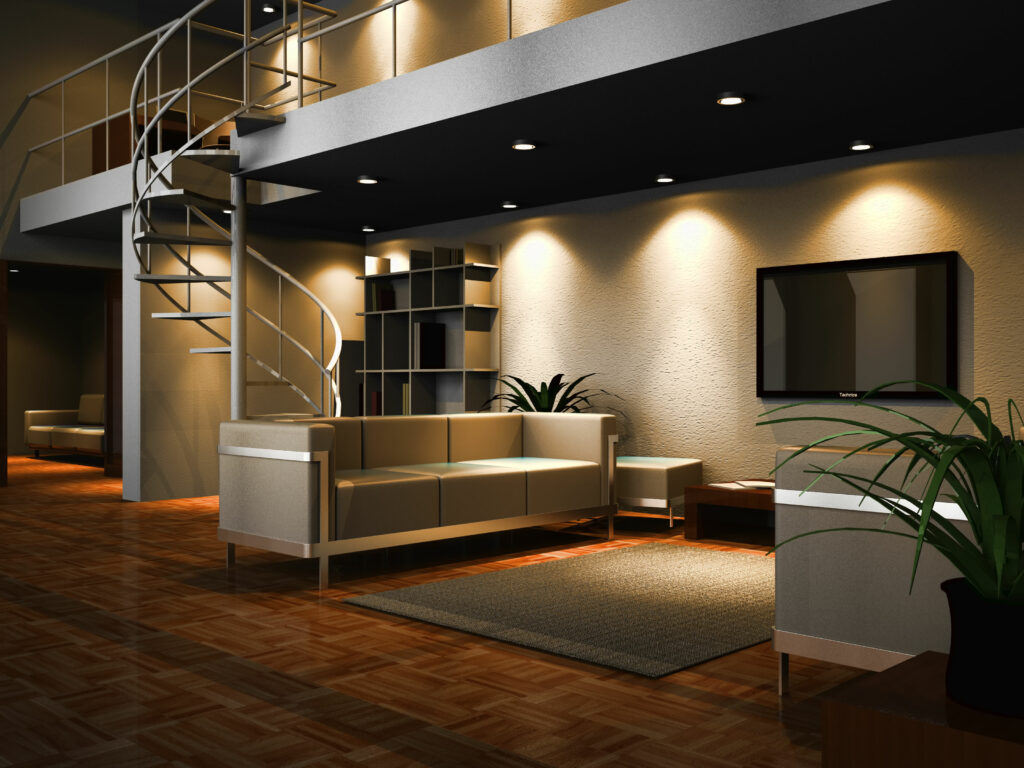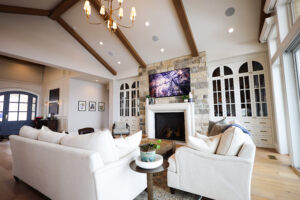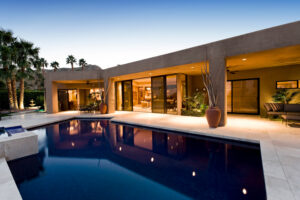The lighting within your home plays a bigger role in your day-to-day life than you may realize. Imagine walking into a room that instantly uplifts your mood. The secret? Lighting. Interior lighting design can transform a space, creating ambiance and matching your style. Custom lighting plans go beyond function and add an extra layer of personality to your home. Keep reading to learn more about the power of interior lighting design and how it compares to standard lighting layouts.
Interior Lighting Design vs Standard Lighting
Have you ever walked into a room and felt immediately at ease or inspired without quite knowing why? Often, the secret ingredient is the lighting. While both interior lighting design and standard lighting aim to light up spaces, they do so in fundamentally different ways.
Standard Lighting Plans
Standard lighting plans typically come bundled with architectural blueprints. They feature basic fixtures—like can lights or ceiling-mounted lights—placed uniformly throughout the house. These plans are functional but generic. They provide general lighting so you can see where you’re going and perform basic tasks. However, they often overlook the nuances that make a space truly comfortable or aesthetically pleasing.
Interior Lighting Design
In contrast, interior lighting design is a customized approach that considers the specific needs and functions of each room. By working with a lighting designer, you receive a tailored lighting plan that goes beyond standard plans. This plan includes specialized lighting solutions like wall wash lights to highlight textures, artwork lights to showcase your favorite pieces, task lighting for specific activities, and ambiance lights to set the mood. The goal is to create a layout where every light serves a specific purpose.
Key Differences
- Customization vs. Standardization: Standard plans offer a one-size-fits-all solution, whereas lighting design provides a personalized approach.
- Functionality: Interior lighting design addresses specific tasks and moods, not just a one-size-fits-all solution.
- Aesthetics: Designer lighting integrates seamlessly with architectural features and interior décor, enhancing the overall aesthetic.
- Technology and Innovation: Lighting designers often incorporate advanced technologies like small aperture lights, trimless fixtures, and smart controls.
By choosing interior lighting design over standard lighting, you’re opting for a thoughtfully curated home environment.
Why Choose a Designer Lighting Plan?
You might be wondering, “Is it really worth investing in a designer lighting plan?” Here are some advantages of working with a lighting designer.
Personalized Solutions for Your Lifestyle
Every home and homeowner is unique. A lighting designer takes the time to understand your specific needs, habits, and preferences. Do you love hosting dinner parties? Task lighting in the kitchen and ambient lighting in the dining area can create the perfect atmosphere. Are you an avid reader? Well-placed reading lights can make your cozy corner even more inviting.
Enhanced Aesthetics
A well-designed lighting plan highlights architectural features, showcases artwork, and adds depth to your spaces. Techniques like wall washing can make a room appear larger, while accent lights draw attention to focal points.
Improved Functionality
Ever tried chopping vegetables in a poorly lit kitchen? Task lighting ensures that every activity, from cooking to reading to working, has optimal light conditions. This not only makes tasks easier but also more enjoyable.
Energy Efficiency and Sustainability
Lighting designers are knowledgeable about the latest energy-efficient technologies. By incorporating LED lights, dimmers, and smart controls, they can create a lighting plan that reduces energy consumption and lowers utility bills. It’s a win-win for you and the environment.
Integration with Smart Home Systems
Modern lighting design often includes integration with smart home technologies. Imagine controlling all your lights from a central hub. With a home automation system like NICE, you can set schedules, create scenes for different moods, and even adjust lighting remotely.
Future-Proofing Your Home
Technology evolves rapidly. A lighting designer stays abreast of the latest advancements, ensuring your home’s lighting system won’t become outdated anytime soon. This future-proofing adds long-term value to your property.
Lighting designers have the expertise to foresee issues you might not consider, such as glare, shadows, or the color rendering of different light sources. Their knowledge ensures a smooth installation process and a final result that meets or exceeds your expectations.
Benefits of a Lighting Design Plan for Every Room
A customized lighting plan doesn’t just benefit one or two rooms; it can work on your entire home.
Living Room
The living room is often the heart of the home—a place for relaxation and socializing. A designer lighting plan can combine ambient lighting for general illumination, task lighting for reading or hobbies, and accent lighting to highlight artwork or architectural features.
Kitchen
In the kitchen, functionality is key. Standard overhead lights can cast shadows exactly where you need light the most. A lighting designer will incorporate under-cabinet lights for countertops, pendant lights over islands, and ambient lighting to ensure the space is both practical and inviting.
Bedroom
Your bedroom should be a sanctuary. Customized lighting can create a calming atmosphere with soft ambient lights, while task lighting provides adequate illumination for reading or dressing. Consider features like adjustable bedside lamps or dimmable fixtures to control the light levels according to the time of day. This helps to support natural circadian rhythms and can have many benefits.
Bathroom
Good lighting is essential in bathrooms for tasks like shaving or applying makeup. A designer will ensure even, shadow-free illumination around mirrors and may incorporate accent lighting to enhance features like a beautiful tile wall or a standalone bathtub.
Home Office
With more people working from home, proper lighting in your office space is essential. Task lighting reduces eye strain, while ambient lighting keeps the space welcoming. A lighting designer can help you avoid glare on computer screens and make sure that your workspace is comfortable and efficient.
A good lighting designer will take your whole home into account when creating a plan that meets your needs and reflects your personal style.
The Misconceptions About Home Lighting Design
Let’s address some common misconceptions about home lighting design.
“It’s Just Decorative Fixtures”
Many people think that lighting design is solely focused on decorative elements like chandeliers or sconces. While these fixtures can be eye-catching, a good lighting design plan goes much deeper. It entails creating a layout that improves functionality, mood, and aesthetics throughout your home.
“It’s Only for Luxury Homes”
Another myth is that lighting design is a luxury reserved for high-end properties. In reality, homes of all sizes and styles can benefit from a customized lighting plan.
“It’s Too Expensive”
While hiring a lighting designer is an investment, it doesn’t have to break the bank. Moreover, the long-term benefits—like energy savings, increased home value, and improved quality of life—often outweigh the initial costs. Plus, designers can work within your budget to prioritize the most impactful changes.
“Standard Lighting Is Good Enough”
Standard lighting plans may provide the bare minimum, but they often fall short in meeting the needs of homeowners. Without considering factors like room function, natural light sources, and personal preferences, standard plans can result in poorly lit spaces that don’t serve you well.
“I Can Do It Myself”
While DIY projects can be satisfying, lighting design involves technical knowledge and an eye for aesthetics that professionals have honed over years of experience. Mistakes can be costly and difficult to fix. Working with a lighting designer ensures a well-thought-out plan that improves your home in ways you might not have considered.
From enhancing the functionality of each room to adding aesthetic touches that reflect your personal style, a customized lighting plan offers benefits that standard lighting simply can’t match.
Create the Perfect Lighting in Your Home with AIS
Lighting design can take your house and turn it into a home. Going one step further, smart lighting can work hand in hand with your home automation system to take your rooms to the next level. At AIS, we specialize in creating personalized lighting designs that enhance the atmosphere and functionality of any space. Our team of experienced designers will work with you to understand your style, needs, and preferences to create a customized lighting plan for each room in your home. From selecting fixtures to creating a layout, we make sure every detail is taken care of. Contact us to learn more, or use our budget calculator to plan expenses.



